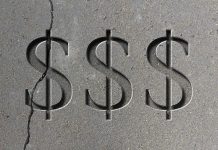Its been a rough outing for the British pound, as GBP/USD has dropped 1.0 percent in the Friday session. In North American trade, the pair is trading just above the 1.28 line. On the release front, US Preliminary GDP for the first quarter posted a strong gain of 1.2%, beating the estimate of 0.9%. This was a strong improvement over the Advance GDP release in April, which showed a gain of 0.7%. However, the news was not as positive from the manufacturing sector, as Core Durable Goods Orders disappointed with a decline of 0.4%, compared to a forecast of +0.4%. Later in the day, we’ll get a look at the UoM Consumer Sentiment report. The markets will also be monitoring the G-7 summit in Sicily, with the war against terror high on the agenda after the Manchester bombing earlier this week.
The Manchester bombing has sent shock waves across Britain, and the pound has dropped about 1 percent on Friday. The currency reacted negatively to a new opinion poll which showed Prime Minister May’s lead over the opposition had narrowed by 5 points. With the entire country on the highest terror alert, the election race could continue to tighten and put pressure on the pound. Currently, GBP/USD is at its lowest level since April 25. On Thursday, British Second Estimate GDP was revised to 0.2%, down from 0.3% back in April. Although the dip was certainly not dramatic, it was well short of GDP in Q4, which posted a respectable gain of 0.7%. The soft reading comes at a time when other key indicators are missing their estimates, raising concerns that Brexit is finally taking a toll on the British economy. Consumer spending, a key driver of economic growth, had its worst quarter since 2014, as nervous consumers are holding tighter to their purse strings.
Federal Reserve policymakers find themselves in a quandary, as the US economy has been sending conflicting signals with regard to inflation and employment. The labor market remains red hot, as the unemployment rate fell to 4.4 percent in April, its lowest level since 2007. Problem is, inflation hasn’t kept up, and remains below the Fed target of 2 percent. The Fed minutes stated that the central bank plans to raise rates "soon", and the odds of a June hike remain at about 78%, unchanged by the minutes. At the same time, the Fed has provided itself some wiggle room, and could opt to delay a hike until the second quarter if inflation or consumer indicators take an unexpected nosedive. As for additional hikes in 2017, the markets remain skeptical. The odds for a September rate stand at just 37%, with the markets unclear on whether the Fed will make further moves this year if inflation remains below the Fed target. Even if soft first quarter data was a blip, the markets (and possibly Fed policymakers) are concerned that President Trump, who is facing congressional investigations over his connections with the Russian government, may not be able to pass his agenda of cutting taxes and reigning in government spending. Gone are the heady days at the end of 2016, when a red-hot US economy had analysts predicting four rate hikes in 2017.













